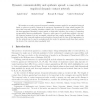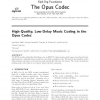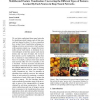CORR
2016
Springer
8 years 8 months ago
2016
Springer
We analyze a recently proposed temporal centrality measure applied to an empirical network based on person-to-person contacts in an emergency department of a busy urban hospital. ...
CORR
2016
Springer
8 years 8 months ago
2016
Springer
The IETF recently standardized the Opus codec as RFC6716. Opus targets a wide range of real-time Internet applications by combining a linear prediction coder with a transform code...
CORR
2016
Springer
8 years 8 months ago
2016
Springer
We study a novel machine learning (ML) problem setting of sequentially allocating small subsets of training data amongst a large set of classifiers. The goal is to select a class...
CORR
2016
Springer
8 years 8 months ago
2016
Springer
—In a public-key infrastructure (PKI), clients must have an efficient and secure way to determine whether a certificate was revoked (by an entity considered as legitimate to do...
CORR
2016
Springer
8 years 8 months ago
2016
Springer
—This paper presents a shape-theoretic framework for dynamical analysis of nonlinear dynamical systems which appear frequently in several video-based inference tasks. Traditional...
CORR
2016
Springer
8 years 8 months ago
2016
Springer
CORR
2016
Springer
8 years 8 months ago
2016
Springer
We can better understand deep neural networks by identifying which features each of their neurons have learned to detect. To do so, researchers have created Deep Visualization tec...
CORR
2016
Springer
8 years 8 months ago
2016
Springer
Generative reconstruction methods compute the 3D configuration (such as pose and/or geometry) of a shape by optimizing the overlap of the projected 3D shape model with images. Pr...
CORR
2016
Springer
8 years 8 months ago
2016
Springer
We present a tool for reasoning in and about propositional sequent calculi. One aim is to support reasoning in calculi that contain a hundred rules or more, so that even relatively...
CORR
2016
Springer
8 years 8 months ago
2016
Springer
Students in online courses generate large amounts of data that can be used to personalize the learning process and improve quality of education. In this paper, we present the Late...



